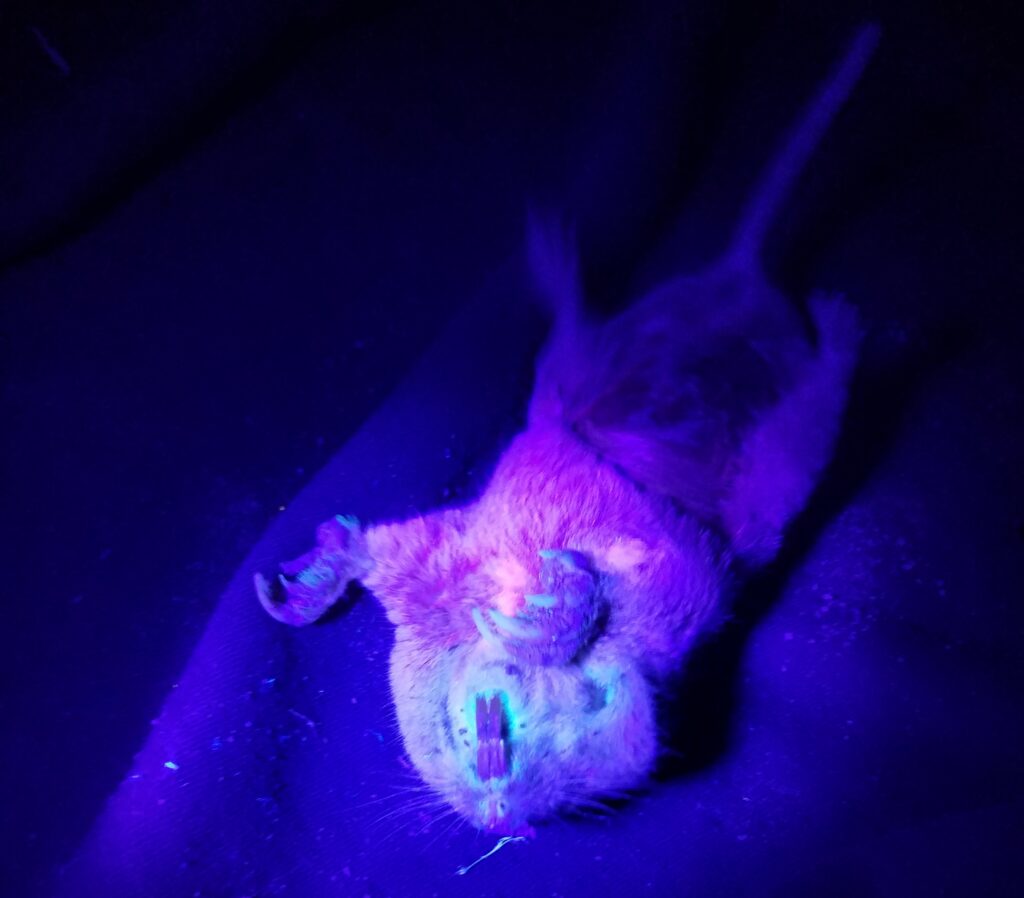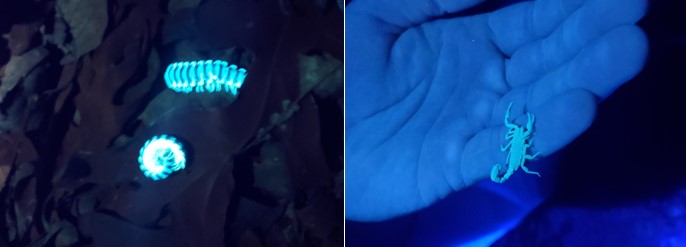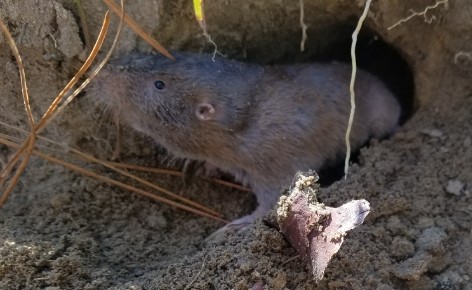
Image 1. A southeastern pocket gopher fluorescing under UV light. This gopher was Mel, named after Mel Blanc who voiced the Goofy Gophers. She was sedated and then released.
By: JT Pynne
Most people know that mammals have hair and are endotherms. But, did you know that some mammals are characterized by something brighter? Something that glows, but can only be seen in the dark? Some shocking new discoveries have illuminated more questions about mammals across the globe and why they glow under ultraviolet (UV) light.
Biofluorescence vs. bioluminescence
Bio here refers to the fact that these glowing critters are living animals. Fluorescence is the absorption and re-emittance of light particles, while luminescence is the chemical creation of light. A white t-shirt at a cosmic bowling alley is an example of the re-emittance of near UV light, or fluorescence (and it’s actually the phosphors in the detergents that really glow). For bioluminescence, think about fireflies creating a chemical reaction in their abdomens that result in that signature yellow glow or the famous bioluminescent algae in the ocean.
Other Mammals
We’ve long known about the biofluorescence of corals, arthropods (image 2), fish, birds, reptiles, amphibians, fungi, and some other taxa, though not to a great extent. Mammal biofluorescence is a relatively new discovery. Over the last couple years there has been some really cool discoveries, all of which happened in the dark. In the 80s, researchers discovered that opossums fluoresce, or glow, under UV light and called it “psychedelic”. More recently in 2018 and on, UV fluorescence has been documented in European hedgehogs, flying squirrels, platypus, springhares, some Australian mammals like Tasmanian devils (yes, Taz from the Looney Tunes should glow under UV light), with the latest discovery occurring in pocket gophers. Because the gopher in Caddyshack is technically a groundhog, Bill Murray may not have been able to use a blacklight to go night hunting to help him get his gopher nemesis.

Image 2. Flat backed millipede (right) and scorpion exhibiting blue biofluorescence under UV light.
Pocket gophers that glow
Glow-phers, as I have begun to affectionately call them, are strange creatures already. They have been described as “homely, belligerent sausages,” and “angry russet potatoes that glow” both of which I assume are also affectionate. In Georgia, we have the southeastern pocket gopher which occurs in the sandy/loamy Coastal Plain soils. Many people have never heard of them because they spend the majority of their lives underground. They create mounds on the surface from displaced soil in their tunnel systems, hence the nickname sandy mounders. Pocket gophers are known as ecosystem engineers because they “engineer” their surroundings. Because they live underground, they have adaptations for digging including external, fur-lined cheek pouches, enlarged forelimbs with large claws, and their lips can close behind their teeth to prevent soil from getting in their mouth while chewing on roots. Pocket gophers are a valuable species that occurs in open and diverse understories. They provide soil aeration, nutrient turnover, bare ground for plant colonization, and protective shelter for many commensal species. It also turns out that they are one of only a few species of mammals that fluoresce under UV light.

Image 3. A southeastern pocket gopher in checking out what caused her tunnel to open up. Hint: it was me, I dug open her tunnel so I could shine a UV light on her for a second.
Reasons
These discoveries lead to one big question: why? Researchers don’t really know why these mammals glow, but we have some theories. While humans can see the white light spectrum (think ROY G BIV), many animals are tuned into the infrared or ultraviolet spectrum on either side of the white light spectrum. For example, flowers look different to bees than what we know because of the emittance and interpretation of light. With these mammalian discoveries, most of the “glowers” are active during low light periods of the day. During these low light periods, it’s likely more common to come across species with UV-sensitive vision. It could possibly be diet related, where the animals consume something containing fluorescent compounds and digest them into their skin and fur. This would make sense with food generalists like flying squirrels which eat everything, but not as much sense for carnivorous Tasmanian devils. Also, why would some generalists glow, but other not? Another theory is that biofluorescence is a form of communication within a species. It may help a pocket gopher recognize that it is in another pocket gopher’s tunnel system, instead of in a tunnel created by one of their major predators, the pine snake. Potentially, it is that it is an antipredator defense mechanism. If you are a prey species, and your predator sees UV spectrums and hunts at night, it would behoove you to blend in with all the other fluorescence from plants and fungus where you live. That way a flying squirrel trying to escape an owl can use it’s biofluorescence as camouflage to disappear in some vegetation cover. Based on several observations, pocket gophers only come above ground to move around a couple times in their lifetimes. Why would a species that lives where there is no light, need to fluoresce under UV light? This question throws a small wrench in the gears of the night-active predator avoidance adaptation for biofluorescence. If the biofluorescent trait only exists for the brief moments that pocket gophers are above ground as antipredator defense, it must not be very energetically costly to create biofluorescent pigments. An additional theory is that it is a retained trained from “older” mammal groups like marsupials and monotremes. This applies to the opossums and platypus, but not to flying squirrels or pocket gophers. Lastly, it is possible that it just has something to do with low-light adaptations over time. Most of the glowing mammals currently discovered are nocturnal (active at night) or crepuscular (active at dusk/dawn). Although, the wrench in this gear yet again is pocket gophers, which live their lives underground where there is no light penetration. Pocket gophers are fossorial, so they are not necessarily nocturnal, crepuscular, or diurnal. This makes them strange candidates for the biofluorescent phenomenon in general. Some studies have shown that their activity periods peak during the midmorning and mid evening, but this is likely due to temperature fluctuations (see Pynne et al. 2021) rather than time of day. Of course, the frustrating part is that there could be no explanation and it is all random occurrence, or it’s something that we have yet to discover.

Image 4. A southeastern pocket gopher’s vibrissae and fur around its forelimb fluorescing blue. This only occurred in a few of the live specimens.
Try it!
Besides the shining adorability and vibrant fierceness, there is a something glowing about pocket gophers and their biofluorescent relatives. One this for sure is that the more we discover, the more questions we have, but also the more question that get answered. UV flashlights are relatively common now, and are available at most pet stores. Pick one up and go see what kind of plants, insects and animals fluoresce in your own backyard!

Recent Comments